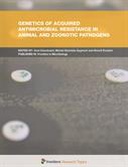Explore

Genetics of Acquired Antimicrobial Resistance in Animal and Zoonotic Pathogens
0 Ungluers have
Faved this Work
Login to Fave
Development and spread of antimicrobial resistance is the result of an evolutionary process by which microorganisms adapt to antibiotics through several mechanisms including alteration of drug target by mutation and horizontal transfer of resistance genes. The concomitant occurrence of independent antimicrobial resistance mechanisms is a serious threat to human health and has appeared in several emerging epidemic clones over the past decade in humans and also in animals. The increasing prevalence of antimicrobial drug resistance among animal and zoonotic foodborne pathogens is of particular concern for public health. In this Ebook, we gathered a collection of articles which deal with the most important aspects of the genetics of acquired antimicrobial resistance extending from medically-important resistance, emerging epidemic resistant clones, main mobile genetic elements spreading resistance, resistomes, dissemination between animals and humans, to the “One Health” concept.
This book is included in DOAB.
Why read this book? Have your say.
You must be logged in to comment.
Rights Information
Are you the author or publisher of this work? If so, you can claim it as yours by registering as an Unglue.it rights holder.Downloads
This work has been downloaded 224 times via unglue.it ebook links.
- 89 - mobi (CC BY) at Unglue.it.
- 71 - epub (CC BY) at Unglue.it.
- 64 - pdf (CC BY) at Unglue.it.
Keywords
- Antimicrobial resistance gene
- food-producing animal
- integrative element
- Integron
- Mutation
- One Health
- pet
- plasmid
- resistome
Links
DOI: 10.3389/978-2-88945-394-8Editions

